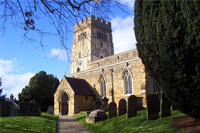| Sources (hover for more info) |
| Civil Registration |
| Census |
| Poor Law Records |
Gathering What Has Been Done
The first concern for personal research is to find a place to start. Ideally, research should begin with an ancestor who came to the United States in the mid-19th century (or closer in time to you) where there is at least certainty of the county of origin in England. If the ancestor migrated before 1800 and the county of origin is undocumented, further research is required on this side of the ocean. Frequently, the researcher is faced with more than one starting point. In that case either concentrate on the least common surname or focus on several names (up to 6-8) that share a common location (say a radius of 10-20 miles).
The first step in research is a gathering phase where you survey claims about your starting point and results of the previous research of others. Start with records in your own home and contact other relatives that you suspect have an interest in old family records. There are a number of websites that could aid in this process. A sampling of those you might try when just starting out might include:
- * Ancestry.com (Click on Search and then Public Member Trees)
- FamilySearch.org (Click on FamilyTree and then Tree)
- * FindMyPast.com (Click on Family Tree)
- * MyHeritage.com (Click on Research and then Family Trees)
*These are subscription sites but free access is available on the computers at the Family History Library in Salt Lake City and the BYU Family History Library and online through FamilySearch Partner Access
At this stage you will be dealing with some documents and a lot of second-hand information. Be careful to note any sources used by other researchers. Now go to the FamilySearch website. Click on records and then on England. FamilySearch has indexed a large amount of English church records. Search for all of the names in England from your starting point back. Be sure to look in the “England Births and Christenings, 1538-1975,” “England Deaths and Burials, 1538-1991,” and “England Marriages, 1538-1973” collections. Individual English counties also have collections of church records that can be searched through. Not all information from the record is included in the index so it is always important to find the original image. These indexes are a good starting place. Church records indexed here will be identified by type of record and batch number. See church records to learn more about batch number searches. Ancestry.com and FindMyPast.com also have large collections of records, both indexes and images.
At this point, you should also consider the possibility that your family might appear in printed records such as family histories and county histories. The most useful histories for specific English families were published in the 19th century or earlier. However, they tend to be elitist in nature and may not be all that helpful until you have been able to document your lines back to around 1700. They should then be revisited more thoroughly than in the initial search phase. The county histories may assist in determining the origins of 17th century emigrants.
After analyzing the results of your first search efforts, you are faced with the decision of what to do next. You may have found that others are currently engaged in researching the same lines and feel impressed to coordinate further research with them, you may have obtained a better idea of where to begin your own research, or you may wish to survey another line. If the decision is to begin research in original records, you will have to take into consideration the following: the need for maps that fit the time period and places of interest and how to keep up to date.
 Ideally, research should begin with an ancestor who came to the United States in the mid-19th century (or closer in time to you) where there is at least certainty of the county of origin in England. If the ancestor migrated before 1800 and the county of origin is undocumented, further research is required on this side of the ocean. Frequently, the researcher is faced with more than one starting point. In that case either concentrate on the least common surname or focus on several
Ideally, research should begin with an ancestor who came to the United States in the mid-19th century (or closer in time to you) where there is at least certainty of the county of origin in England. If the ancestor migrated before 1800 and the county of origin is undocumented, further research is required on this side of the ocean. Frequently, the researcher is faced with more than one starting point. In that case either concentrate on the least common surname or focus on several  At this point, you should also consider the possibility that your family might appear in printed records such as
At this point, you should also consider the possibility that your family might appear in printed records such as